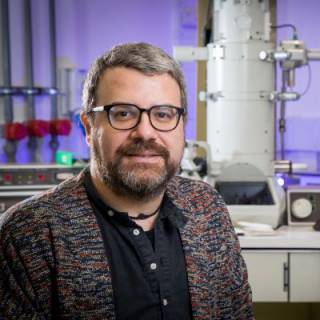Engineered nanoparticles designed and constructed by Professor Giuseppe Battaglia could radically improve the efficacy of chemotherapy.
A good chemotherapeutic agent should be an effective killer of cancer cells. However, even when they are, their use may be limited if they cannot gain access to cancer cells, or if they are too damaging to other body tissues. Targeting is thus a key aspect of cancer treatment.
While the idea of packaging cytotoxic agents into carrier structures is not new, Professor Battaglia's group has developed a number of innovations that could provide a safe and reliable platform for the targeted delivery of anti-cancer drugs. Based in the UCL Department of Chemistry, he has assembled a multidisciplinary team of chemists, physicists, engineers and biologists that has deconstructed biological carrier systems, from vesicles to viruses, identified the key principles underlying their form and function, and used the principles of synthetic chemistry to fabricate artificial versions able to perform similar functions.
Biological transport relies heavily on lipid-based sacs, or vesicles. Rather than lipids, Professor Battaglia has based his nanoparticle carriers on polymers, which are easier to synthesise and modify chemically, spontaneously assemble into particles, and are both robust and flexible enough for use in the challenging environment in the body. These 'polymersomes' can carry all kinds of cargos, including antibodies, DNA and RNA, as well as anti-cancer drugs.
Targeting is achieved by incorporating peptide fragments representing the antigen-binding region of antibodies onto the surface of polymersomes. Rather than a single high-affinity binding interaction, polymersomes again mimic biological interactions by incorporating multiple medium-affinity binding interactions. This ensures that the carriers preferentially attach to cells carrying multiple target antigens, and are less likely to bind to normal host cells that happen to carry one of the target antigens. The polymersomes are also designed to have a protective outer 'brush' layer that camouflages recognition structures, so that they are not attacked by the host immune system and remain immunologically inert.
In cellular and preclinical studies, use of polymersomes has significantly improved the potency of existing chemotherapeutics [1]. One potentially major advantage of polymersomes is their ability to cross the blood-brain barrier, for example by exploiting endogenous transporter systems [2]. (His group has also developed innovative self-propelling particles - 'nano-swimmers' - that can follow chemical gradients and show even greater ability to cross the blood-brain barrier [3].) A further promising application is the direct injection of polymersomes to treat peritoneal cancers, which lack a blood supply and so are difficult to treat chemotherapeutically [4].
Additional chemical tricks enable polymersomes to deliver therapeutics directly into the heart of a cell - where many important cancer targets are found. One challenge for nanocarrier delivery is that when particles are taken up by a cancer cell, they typically enter lysosomal pathways, which rapidly digest protein cargos such as antibodies. Professor Battaglia has developed pH-sensitive polymersomes that explosively disassemble at pH 6, releasing their cargo before it has been broken down [5]. This massively increases the local intracellular concentration of chemotherapeutic and drug potency.
Having demonstrated success in pre-clinical models, Professor Battaglia's group is working to scale up the technology and prepare for first-in-human studies. Because his products are mostly based on re-use of agents already used in humans (but in novel combinations), this should simplify the pathway to regulatory approval. Furthermore, his approach in effect sits mid-way between small-chemical therapeutics and complex biologicals, combining the synthetic simplicity of the former with the biological complexity of the latter. In prototype scale up, his group has already been able to synthesise hundreds of grammes of product, suggesting that production costs could ultimately be relatively low.
To demonstrate proof of principle, his work is currently focused on delivery of existing chemotherapeutic drugs, applied to brain cancer and peritoneal cancer where there are significant obstacles to the use of cancer drugs. However, as well as other types of therapeutic, the approach could potentially provide a way to use agents that are effective killers of cancer cells but are too toxic. In addition, with industrial partners, Professor Battaglia is exploring how polymersomes could be used to enhance the cancer-killing properties of immune cells, to boost immunotherapy.
And in the long term, he suggests that the platform is sufficiently flexible that it could be used to achieve personalised cancer therapy. Indeed, characterisation of patients' tumour cells could be used to identify specific tumour antigen targets to inform the design and manufacture of individualised therapeutics.
- Colley HE et al. Polymersome-mediated delivery of combination anticancer therapy to head and neck cancer cells: 2D and 3D in vitro evaluation. Mol Pharm. 2014;11(4):1176-88.
- Tian X et al. LRP-1-mediated intracellular antibody delivery to the Central Nervous System. Sci Rep. 2015;5:11990.
- Joseph A et al. Chemotactic synthetic vesicles: design and applications in blood brain barrier crossing. Science Adv. 2017;3(8):e1700362
- Simón-Gracia L et al. Paclitaxel-loaded polymersomes for enhanced intraperitoneal chemotherapy. Mol Cancer Ther. 2016;15(4):670-9.
- Ellis E et al. Biocompatible pH-responsive nanoparticles with a core-anchored multilayer shell of triblock copolymers for enhanced cancer therapy. J. Mater. Chem. B. 2017;5:4421
 Close
Close


